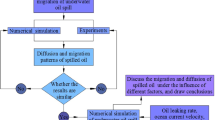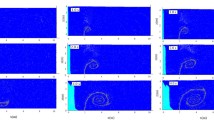Abstract
Computational fluid dynamics (CFD) codes are being increasingly used in the simulation of submarine oil spills. This study focuses on the process of oil spills, from damaged submarine pipes, to the sea surface, using numerical models. The underwater oil spill model is developed, and a description of the governing equations is proposed, along with modifications required for the particalization of the control volume. Available experimental data were introduced to evaluate the validity of the CFD predictions, the results of which proved to be in good agreement with the experimental data. The effects of oil leak rate, leak diameter, current velocity, and oil density are investigated, by the validated CFD model, to estimate the undersea leakage time, the lateral migration distance, and surface diffusion range when the oil reaches the sea surface. Results indicate that the leakage time and lateral migration distance increase with decreasing leak rates and leak diameter, and increase with increasing current velocity and oil density. On the other hand, a large leak diameter, high density, high leak rate, or fast currents result in a greater surface diffusion range. The findings and analysis presented here will provide practical predictions of oil spills, and guidance for emergency rescues.
Similar content being viewed by others
References
ASCE Task Committee on Modeling of Oil Spills. 1996. State-of-theart Review of modeling transport and fate of oil spills. Journal of Hydraulic Engineering, 122(11): 594–609, doi: 10.1061/(ASCE)0733-9429(1996)122:11(594)
Bemporad G A. 1994. Simulation of round buoyant jet in stratified flowing environment. Journal of Hydraulic Engineering, 120(5): 529–543, doi: 10.1061/(ASCE)0733-9429(1994)120:5(529)
Boufadel M C, Abdollahi-Nasab A, Geng X L, et al. 2014. Simulation of the landfall of the deepwater horizon oil on the shorelines of the Gulf of Mexico. Environmental Science & Technology, 48(16): 9496–9505
Brandvik P J, Johansen Ø, Leirvik F, et al. 2013. Droplet breakup in subsurface oil releases -Part 1: Experimental study of droplet breakup and effectiveness of dispersant injection. Marine Pollution Bulletin, 73(1): 319–326, doi: 10.1016/j.marpolbul.2013.05.020
Chen Haibo, An Wei, You Yunxiang, et al. 2015. Numerical study of underwater fate of oil spilled from deepwater blowout. Ocean Engineering, 110: 227–243, doi: 10.1016/j.oceaneng.2015.10.025
Clift R, Grace J R, Weber M E. 1978. Bubbles, Drops, and Particles. New York: Academic Press
Dasanayaka L K, Yapa P D. 2009. Role of plume dynamics phase in a deepwater oil and gas release model. Journal of Hydro-environment Research, 2(4): 243–253, doi: 10.1016/j.jher.2009.01.004
Deng Zengan, Yu Ting, Jiang Xiaoyi, et al. 2013. Bohai Sea oil spill model: a numerical case study. Marine Geo-physical Research, 34(2): 115–125, doi: 10.1007/s11001-013-9180-x
Fan L N. 1967. Turbulent buoyant jets into stratified or flowing ambient fluids. Pasadena, Calif: W M Keck Labor-atory for Hydraulics and Water Resources, California Institute of Technology
Fannelop T K, Sjoen K. 1980. Hydrodynamics of underwater blowouts. In: AIAA 8th Aerospace Sciences Meeting. Pasadena, California: AIAA
Fanneløp T K, Hirschberg S, Küffer J. 1991. Surface current and recirculating cells generated by bubble curtains and jets. Journal of Fluid Mechanics, 229(1): 629–657
Frick W E. 1984. Non-empirical closure of the plume equations. Atmospheric Environment (1967), 18(4): 653–662, doi: 10.1016/0004-6981(84)90252-X
Frick W E. 1994. A Lagrangian philosophy for plume modeling [dis-sertation]. Southampton: Oregon State University
Hackett B, Comerma E, Daniel P, et al. 2009. Marine oil pollution prediction. Oceanography, 22(3): 168–175, doi: 10.5670/oceanog
Jiang Meirong, Li Zhigang, Yu Jianxing. 2016. Effect of grid density on numerical result for oil leakage from subsea pipeline. Journal of Tianjin University (Science and Technology) (in Chinese), 49(9): 907–914
Johansen Ø. 2000. DeepBlow-a Lagrangian plume model for deep water blowouts. Spill Science & Technology Bulletin, 6(2): 103–111
Johansen Ø. 2003. Development and verification of deep-water blowout models. Marine Pollution Bulletin, 47(9-12): 360–368, doi: 10.1016/S0025-326X(03)00202-9
Johansen Ø, Brandvik P J, Farooq U. 2013. Droplet breakup in subsea oil releases -Part 2: Predictions of droplet size distributions with and without injection of chemical dispersants. Marine Pollution Bulletin, 73(1): 327–335, doi: 10.1016/j.marpolbul.2013.04.012
Lee J H W, Cheung V. 1990. Generalized Lagrangian model for buoyant jets in current. Journal of Environmental Engineering, 116(6): 1085–1106, doi: 10.1061/(ASCE)0733-9372(1990)116:6(1085)
Li Wei, Pang Yongjie, Lin Jianguo, et al. 2013. Computational modeling of submarine oil spill with current and wave by FLUENT. Research Journal of Applied Sciences, Engineering and Technology, 5(21): 5077–5082, doi: 10.19026/rjaset.5.4400
Marta-Almeida M, Ruiz-Villarreal M, Pereira J, et al. 2013. Efficient tools for marine operational forecast and oil spill tracking. Marine Pollution Bulletin, 71(1–2): 139–151, doi: 10.1016/j.marpolbul. 2013.03.022
McDougall T J. 1978. Bubble plumes in stratified environments. Journal of Fluid Mechanics, 85(4): 655–672, doi: 10.1017/S0022112078000841
Milgram J H. 1983. Mean flow in round bubble plumes. Journal of Fluid Mechanics, 133(1): 345–376
Paiva P M, Lugon J J, Barreto A N, et al. 2017. Comparing 3d and 2d computational modeling of an oil well blowout using MOHID platform -A case study in the Campos Basin. Science of the Total Environment, 595: 633–641, doi: 10.1016/j.scitotenv.2017.04.007
Rye H. 1994. Model for calculation of underwater blow-out plume. Proceedings of the Seventeenth Arctic and Marine Oil Spill Program (AMOP) Technical Seminar, 2: 849–865
Rye H, Brandvik P J. 1997. Verification of subsurface oil spill models. In: Proceedings of the 1997 International Oil Spill Program Conference. Fort Lauderdale, Florida: IOSC, 551–577
Rye H, Brandvik P J, Reed M. 1996. Subsurface oil release field experiment-observations and modeling of subsur-face plume behavior. Proceedings of the Nineteenth Arctic and Marine Oil Spill Program (AMOP) Technical Seminar, 2(1): 1417–1435
Schatzmann M. 1979. An integral model of plume rise. Atmospheric Environment (1967), 13(5): 721–731, doi: 10.1016/0004-6981 (79)90202-6
Spaulding M L. 2017. State of the art review and future directions in oil spill modeling. Marine Pollution Bulletin, 115(1–2): 7–19, doi: 10.1016/j.marpolbul.2017.01.001
Takemura F, Yabe A. 1999. Rising speed and dissolution rate of a carbon dioxide bubble in slightly contaminated water. Journal of Fluid Mechanics, 378(1): 319–334
Tangley L. 2010. Oil spill hammers brown pelicans. National Wildlife, 48(6): 12
Wang Chuanyuan, Chen Bing, Zhang Baiyu, et al. 2013. Fingerprint and weathering characteristics of crude oils after Dalian oil spill, China. Marine Pollution Bulletin, 71(1–2): 64–68, doi: 10.1016/j.marpolbul.2013.03.034
Xu Qing, Li Xiaofeng, Wei Yongliang, et al. 2013. Satellite observations and modeling of oil spill trajectories in the Bohai Sea. Marine Pollution Bulletin, 71(1–2): 107–116, doi: 10.1016/j.marpolbul. 2013.03.028
Yang Yiqiu, Li Yan, Liu Guimei, et al. 2017. A hindcast of the Bohai Bay oil spill during June to August 2011. Acta Oceanologica Sinica, 36(11): 21–26, doi: 10.1007/s13131-017-1135-7
Yapa P D, Wimalaratne M R, Dissanayake A L, et al. 2012. How does oil and gas behave when released in deep-water? Journal of Hydro-Environment Research, 6(4): 275–285, doi: 10.1016/j.jher. 2012.05.002
Yapa P D, Zheng Li. 1997. Simulation of oil spills from underwater accidents I: Model development. Journal of Hydraulic Research, 35(5): 673–688, doi: 10.1080/00221689709498401
Yapa P D, Zheng Li, Nakata K. 1999. Modeling underwater oil/gas jets and plumes. Journal of Hydraulic Engi-neering, 125(5): 481–491, doi: 10.1061/(ASCE)0733-9429(1999)125:5(481)
Zhang Jun, Zang Xiaogang, Zhang Yuanchun, et al. 2016. Dynamic characteristics of plume/jet from underwater pipe downward leakage. CIESC Journal (in Chinese), 67(12): 4969–4975
Zheng Li, Yapa P D. 1998. Simulation of oil spills from underwater accidents II: Model verification. Journal of Hydraulic Research, 36(1): 117–134, doi: 10.1080/00221689809498381
Zheng Li, Yapa P D. 2000. Buoyant velocity of spherical and nonspherical bubbles/droplets. Journal of Hydraulic Engineering, 126(11): 852–854, doi: 10.1061/(ASCE)0733-9429(2000)126: 11(852)
Zheng Li, Yapa P D, Chen Fanghui. 2003. A model for simulating deepwater oil and gas blowouts-PartI: Theory and model formulation. Journal of Hydraulic Research, 41(4): 339–351, doi: 10.1080/00221680309499980
Zheng Quanan, Zhao Qing, Nan W, et al. 2010. Oil spill in the Gulf of Mexico and spiral vortex. Acta Oceanologica Sinica, 29(4): 1–2, doi: 10.1007/s13131-010-0044-9
Zhu Hongjun, Lin Pengzhi, Pan Qian. 2014. A CFD (computational fluid dynamic) simulation for oil leakage from damaged submarine pipeline. Energy, 64: 887–899, doi: 10.1016/j.energy. 2013.10.037
Zhu Hongjun, You Jiahui, Zhao Honglei. 2017. Underwater spreading and surface drifting of oil spilled from a submarine pipeline under the combined action of wave and current. Applied Ocean Research, 64: 217–235, doi: 10.1016/j.apor.2017.03.007
Acknowledgments
The authors thank the COOEC water tank experiments for the experimental data support.
Author information
Authors and Affiliations
Corresponding author
Additional information
The National Basic Research Program (973 Program) under contract No. 2014CB046803; the National Natural Science Foundation of China under contract No. 51239008; the National Science and Technology Major Project under contract No. 2016ZX05028005-004.
Rights and permissions
About this article
Cite this article
Yang, Z., Yu, J., Li, Z. et al. Application of computational fluid dynamics simulation for submarine oil spill. Acta Oceanol. Sin. 37, 104–115 (2018). https://doi.org/10.1007/s13131-018-1256-7
Received:
Accepted:
Published:
Issue Date:
DOI: https://doi.org/10.1007/s13131-018-1256-7




